
we have added some new features to the ALS app and improved the user experience. The latest update of the ALS app version 4.0 is available for free download in the Apple App Store and Google Play. We would like to briefly introduce the changes in the current version.
Self-assessment of the course of the disease
The design of the ALS functional rating scale (ALSFRS) has been redesigned. The 12 questions of the questionnaire are now arranged on their own pages. The new arrangement is intended to facilitate completion of the questionnaire.
Also, the display of the ALS progression score and the total ALS functional rating scale score is better displayed on the home page of the app.
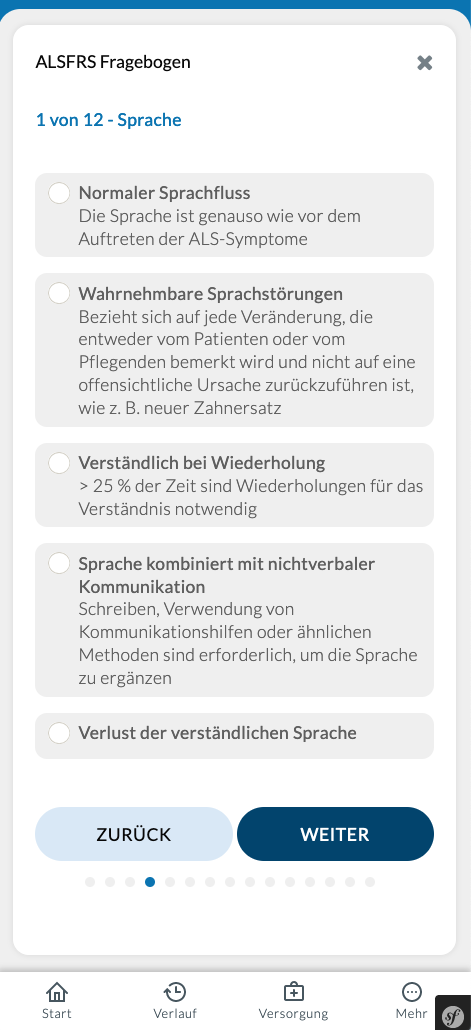
ALS Functional Scale: new arrangement of the 12 questions of the ALSFRS questionnaire. Each question with the five answer options is presented on a separate page.
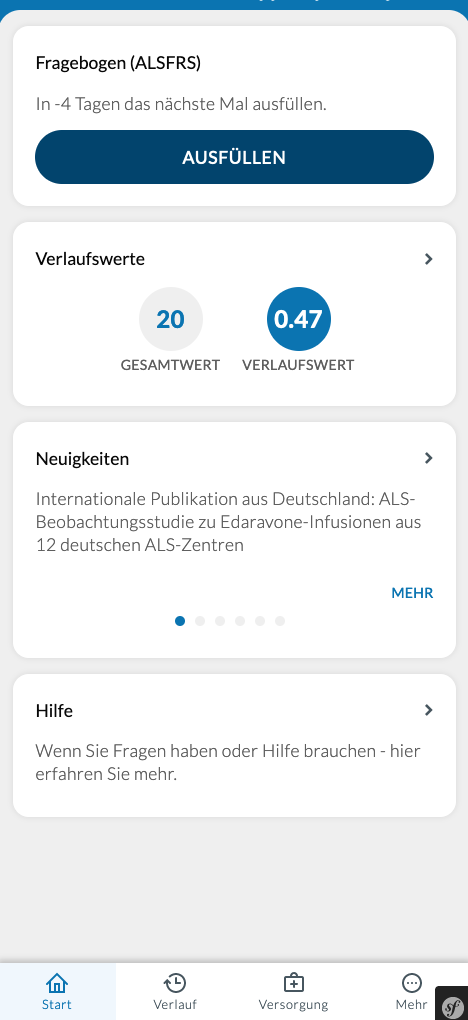
Home page with ALSFRS total value and progression score: The most recent total value of the ALS functional rating scale and the ALS progression value are clearly displayed on the starting page.
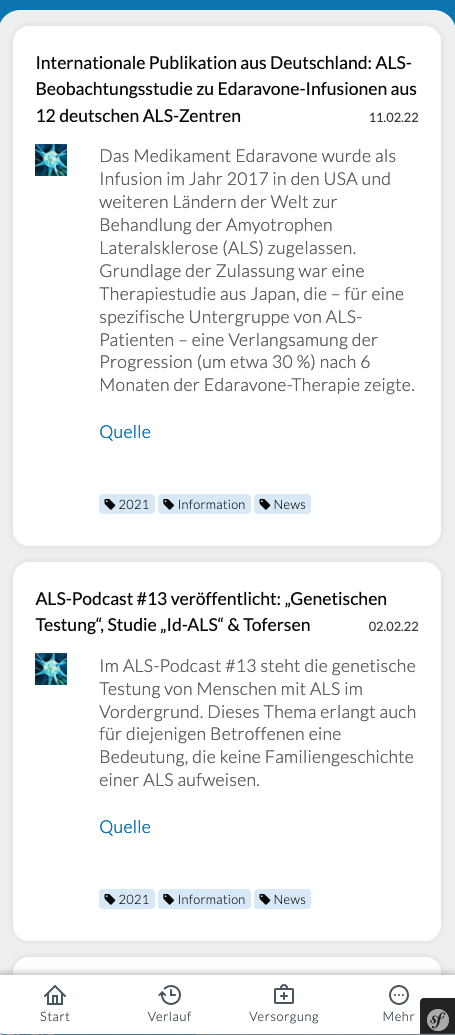
ALS News
For easy and structured information about ALS news, an automatic news history has been added to the app. You can find the news history in the news section on the home page of the app.
Image: The main content of the news history comes from the website www.als-charite.de. The news history gives you the opportunity to quickly read up on certain topics or to delve deeper. The news is oriented to the common questions of people with ALS, about the clinical picture, research, treatment and care.
Chronicle of the course of the disease
People with ALS go through different phases of the disease. A chronicle of the course of the disease has been included in the ALS app for the orientation of those affected and their relatives. In the chronicle, the disease phases of ALS are divided and displayed into phases 1 to 4 based on King's staging (developed at King's College in London). The users have the possibility to inform themselves about suitable support offers in the phases. The respective individual King's Phase is determined by the values in the ALS Functional Scale (ALSFRS questionnaire). What do the disease phases look like in the chronicle? The overview:
Phase of evaluation and assessment (King's Phase 1):
After the diagnosis of ALS, affected persons and their relatives often enter a phase of searching for orientation. Offers to evaluate the disease and to orient themselves to treatment and support options can help in this phase. These offers are intended to support the development of a perspective for the future.
King's Phase 1 contains links to various offers for the individual information needs of the sufferer and their relatives. These include the program for the analysis of the biomarker NF-L as a progression marker of ALS, a study on the identification of genetic changes (genetics of ALS) and an overview of current drug studies. For relatives, the link to a network for relatives may be helpful. Contact with other relatives offers guidance in the new everyday life with the disease.
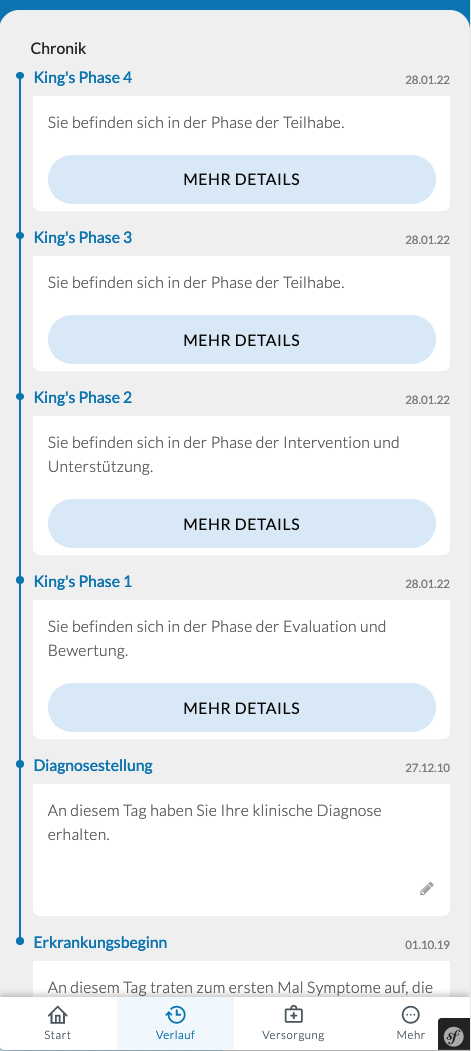
On the page History you will find a chronicle. In the chronicle, the dates of the onset of the disease, the diagnosis and the four disease phases of ALS are presented in chronological order.
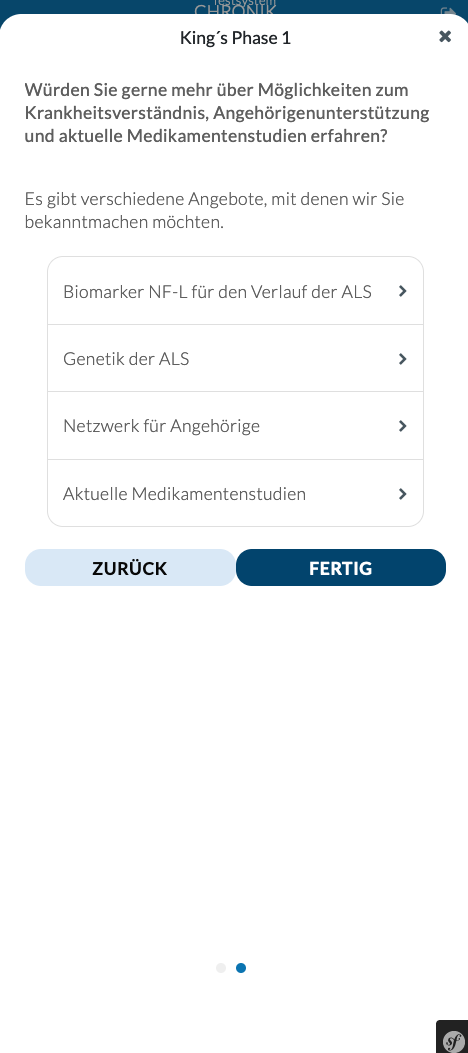
In the phases of the disease (King's phases 1 to 4), suitable offers of support are suggested for those affected and their relatives.
Phase of intervention and support (King's Phase 2)
in the phase of intervention and support (King's Phase 2), many affected persons have the desire to compensate for their motor function limitations with suitable aids in order to retain their independence as long as possible. Pharmacological treatment of symptoms of ALS is also an important topic in this phase of the disease. Participating in research on new treatment options can strengthen the important sense of control.
King's Phase 2 therefore presents appropriate support services through various links, such as the ALS Pharmacy Program, current medication studies, therapeutic exercise trainers in ALS, and the ALS Care Algorithm.
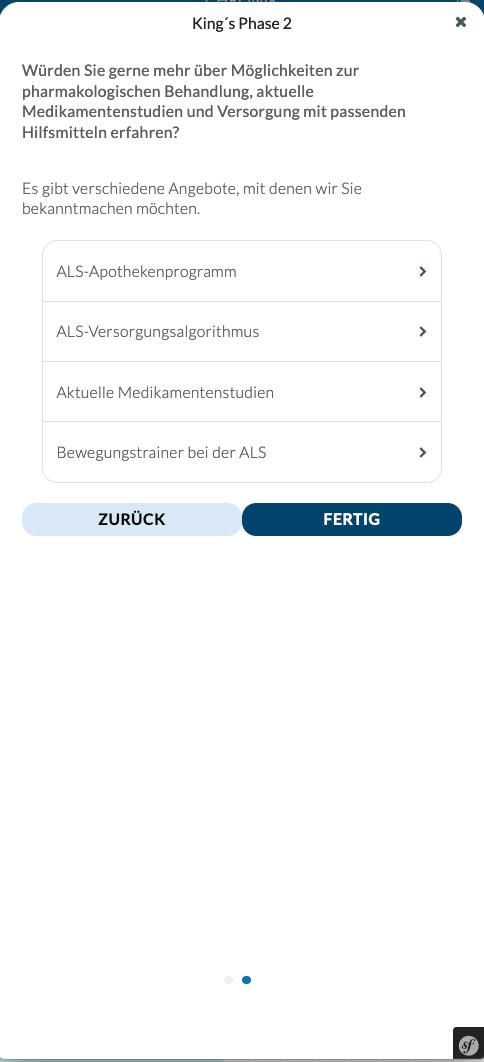
Chronicle with King's Phase 2 disease phase pages present appropriate support services.
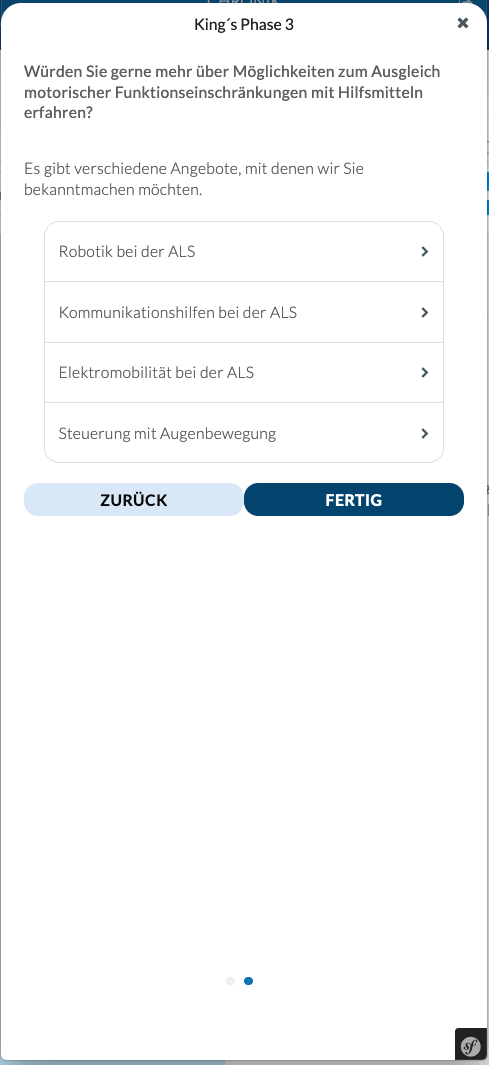
Chronicle with King's Phase 3 disease phase. Appropriate support services are also presented on the pages of this phase.
Participation Phase (King's Phase 3)
In the participation phase (King's phase 3), there are progressive limitations in arm functions, mobility and communication. In this phase, there is a feeling of losing independence and participation in social life. Therefore, it is now important that affected persons use strategies and technologies that can support them in their autonomy and social participation.
In this phase, the chronicle presents suitable offers to compensate for limitations in arm function (robotics in ALS), mobility (electromobility in ALS and control with eye movement) and communication (communication aids in ALS).
Phase of participation with nutritional support and/or ventilation, (King's Phase 4):
In this phase of the disease, the affected person receives nutrition via a feeding tube and/or ventilation. Questions about participation with a feeding tube and/or ventilation become more important. Improving or maintaining the quality of life with a feeding tube and/or ventilation becomes the focus of treatment.
An important role is played by the provision of suitable aids to compensate for motor function restrictions. The chronicle therefore presents offers for the supply of robotics, electromobility and communication aids in ALS. In King's Phase 4, there are open research questions about the utility and use of feeding tubes (PEG tubes) in ALS. Therefore, the Chronicle provides a link to information about a medical trial of PEG feeding in ALS.
The chronicle and the content in the disease phases will be supplemented and further developed in the future. As a result, a specialized range of information based on the course of the disease and the current state of research is to be created.
Communication of the need for care
The design of the notification of a supply requirement for aids or medications has been revised. If aids are needed, several categories are available in the app, ranging from breathing aids to transfer aids. For example, the need for aids for the living environment, a communication aid or nursing aids can be communicated via the app. After communicating your need via the app, you will be contacted by your case managers to plan the next steps for providing you with an assistive device.
If the app indicates that a neurological medication is needed, your case managers are notified immediately. They will take care of your supply of a new or an existing medication. In addition, the app also provides the option to communicate the need for a neurological medication consultation. The user will then be contacted and advised by a pharmacy specializing in ALS at the earliest possible time.
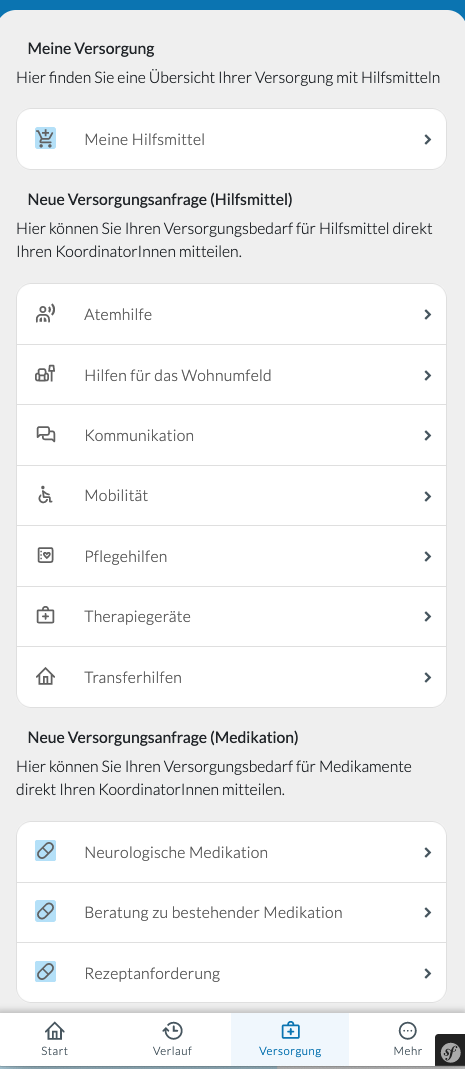
The Supply page allows the user to communicate the need for an assistive device or medication to their coordinators.
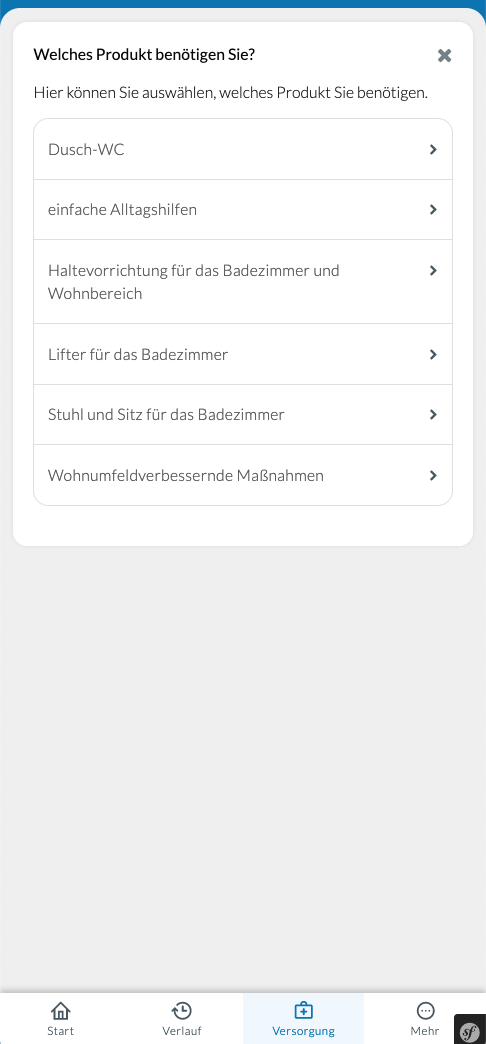
If the user wants to communicate his need for an aid to his case managers, the required aid can be described via a selection menu and a free text field.
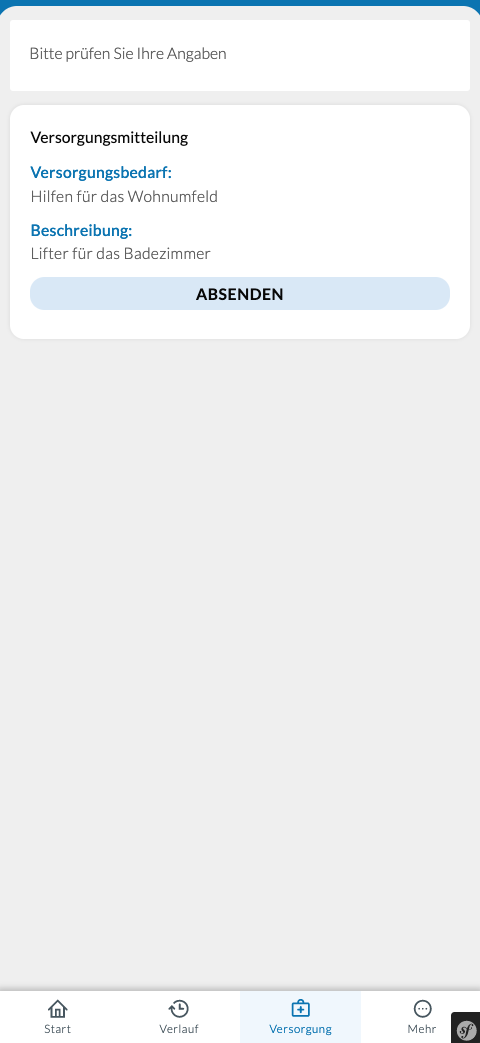
The notice of need is sent to case management. After sending, the case management contacts the user and takes care of the supply.
My supply of assistive devices
The new "My aids" function on the Supply page provides an overview of the current and past supply of aids. In the detailed description of an individual medical aid, you can see the processing status of the supply process and which medical supply store supplies the medical aid. A filter function allows you to filter all aids according to the status of the supply process, the aid category and the date of the most recent supply process.
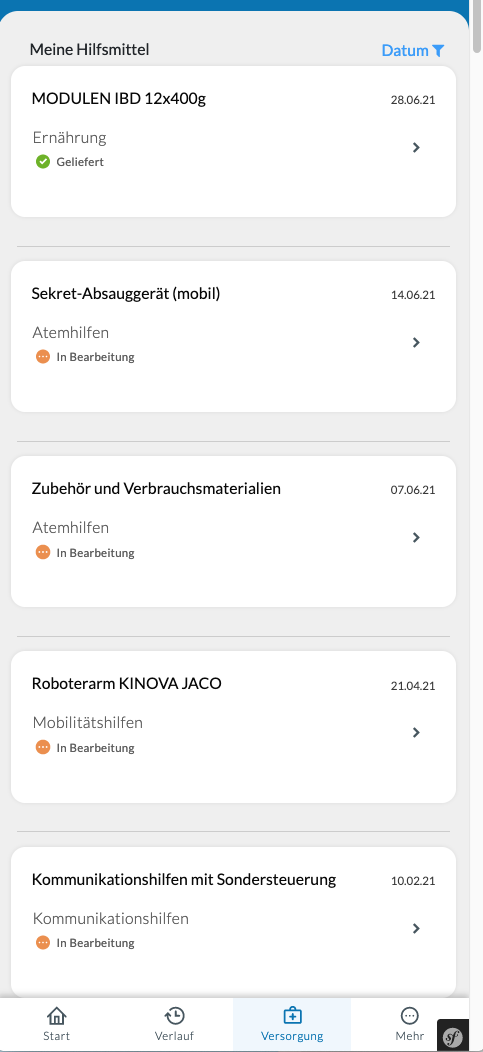
On the Supply page, you will find the "My aids" overview. This overview displays all aids that have been coordinated via your case management.
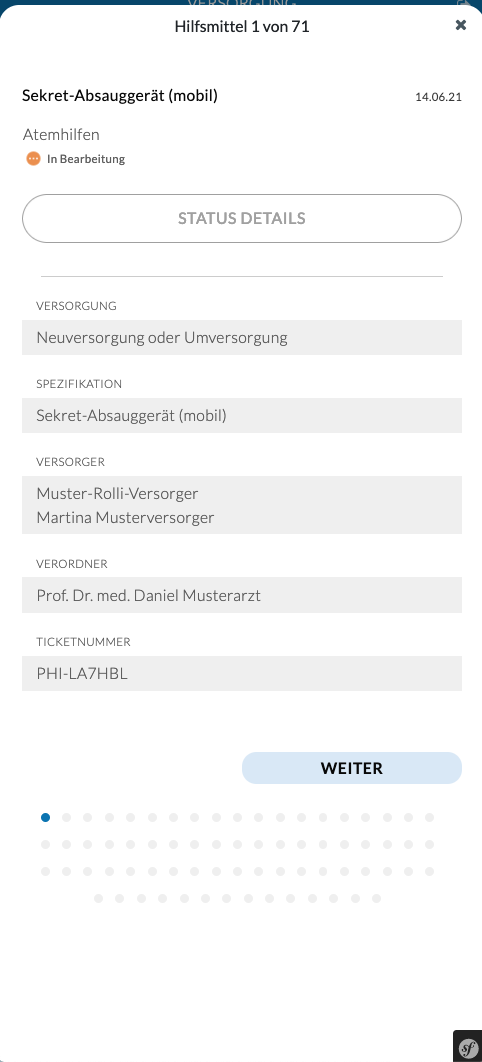
The "My aids" page takes you to the details view of an aid. Among other things, the processing status of the fitting and the supplying medical supply store are displayed in the details.
Push messages
The new ALS app sends short messages to your cell phone or tablet display (push messages). This requires consent to receive push messages. The following push messages will be sent automatically:
- Reminder to complete the ALS Functional Scale.
- Reminder to perform the speech and facial expression analysis
- Notifications about the supply process of an assistive device
Furthermore, individual push messages can be sent to you by your case managers.
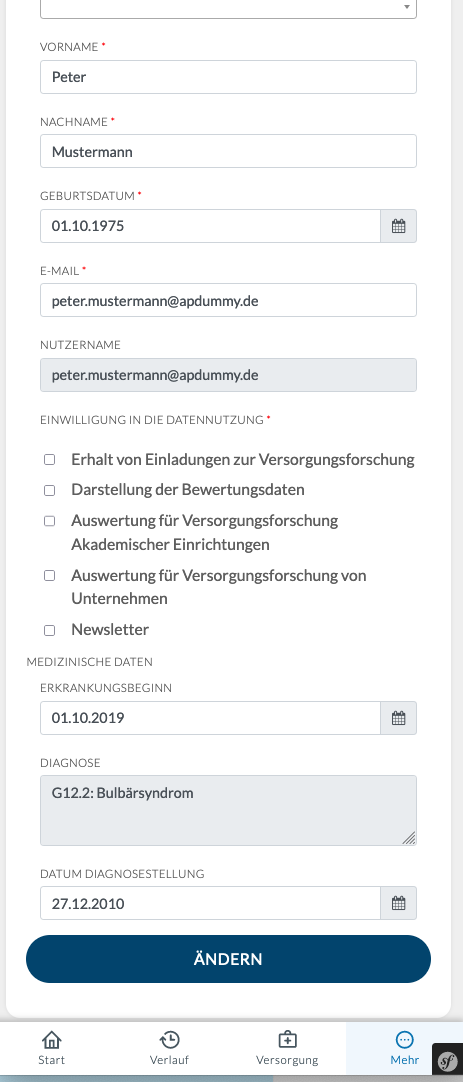
personal data
On the “Personal data” page, your main diagnosis and the dates of onset and diagnosis are documented. These data are important for the calculation of the ALS progression value, the representation of the course of the disease (ALSFRS diagram) and the definition of the phases of the disease (King’s phases) in the chronicle
Kontakt
We appreciate your interest in the new version of the ALS app.
If you have any questions about the technology and use of the new ALS app, please do not hesitate to contact Friedrich Schaudinn.
Friedrich Schaudinn
ALS App Manager
f.schaudinn@ambulanzpartner.de
